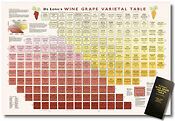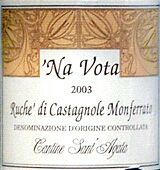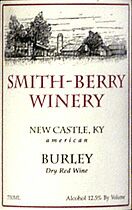|
Wine way off the beaten path
As I wrote in the early days of The 30 Second Wine Advisor, in February 1999, "I always bring an extra sense of anticipation to my first bottle of wine from a country or region I haven't experienced before, or when I take my taste of a wine made from a grape I hadn't previously encountered. That Japanese Cabernet that I picked up in Kyoto or the nondescript Peruvian red that my brother sent from Lima stand out in my palate's memory, not because they were great wines but because they were different. They illustrate the near-infinite diversity that makes wine more interesting than any other beverage." I still feel that way, and my "life list" of grape varieties tasted in the bottle is up to something over 140 now. Recently I ran into a guy who's even more deeply into the pursuit of the rare and obscure than I am. And I'm delighted to report that this gent, Steve De Long, with his wife, Deborah, has recently launched a product so delightfully offbeat (yet educational) that I couldn't resist joining with him to help publicize it. Steve's Wine Grape Varietal Table (pictured above in our Graphics Edition or viewable online at his Website, linked below), is a quality fine-art poster - accompanied with a densely-packed, informative pocket-size book - that displays nearly 200 wine-grape varieties, sorted by color, body and acidity, in a format that should draw a nostalgic "Yeah!" from anyone who's ever sat in a high-school or college chemistry classroom: It is modeled after the classic periodic table of the elements. Just like its scientific predecessor, the Wine Grape Varietal Table organizes its subject rationally, placing similar "elements" nearby each other on the table, ranked with other chemicals, er, wine grapes of similar body, acid and color, from Grenache/Garnacha way down in the dark-purple, low-acid, super-heavyweight corner to Savatiano up in the pale-greenish-gold, "flyweight" upper right. (You'll note that its idiosyncratic nature is futher heightened by the use of boxing terms to generalize about the body of the wines.) Whether you're looking for a grape as common as Pinot Noir (light welterweight, high to moderate acidity) or as obscure as Hondarrabi Zuri (light featherweight, high to very high acidity), you'll find them on the Varietal Table, each entry loaded with concise information about the grape, its identifying characteristics, the wines it's used in, and where it's from. If you have a wine but don't know its composition, the accompanying softcover "Wine and Grape Indexes" book is at hand. A pocket-size volume so comprehensive that it makes all its predecessors look puny, it lists thousands of wines (alphabetized by grape and by wine type within category), imparting the exact grape composition of each. Boxed in a large, sturdy cardboard container, ready for gift-wrapping, this set would make a good gift for any wine enthusiast on your list; and if your recipient (even yourself) qualifies as a true wine "geek," then he's just got to have it. Wine accessories just don't get any more geeky than this ... and that's a compliment.
Steve sells the boxed set for $35. Use the following link to buy, and we'll earn a small commission to help pay the rent at WineLoversPage.com.
While you're at it, if you're already an enthusiastic wine-variety collector who's tasted at least 100 varieties, stop by De Long's Wine Century Club page and download the application form. Your tasting experience qualifies you for free membership in a small but growing club. This informal, light-hearted organization exists solely for the mutual enjoyment of bragging rights. Wine Century Club:
TALK ABOUT WINE ONLINE If you prefer to comment privately, feel free to send me E-mail at wine@wineloverspage.com. I'll respond personally to the extent that time and volume permit. In the spirit of today's exploration, I present notes on two wines made from grape varieties so obscure that only the most ardent wine-grape collector will have heard of either: Ruché, an indigenous red variety grown only around the village of Monferrato in northwestern Italy's Piemonte; and a blend dominated by Munson, an excruciatingly rare grape grown only in Arkansas's Ozarks, bred in modern times and named in honor of the Texas wine pioneer T. V. Munson.
This is a very dark ruby-color wine, black at the center. A remarkably spicy character highlights its aroma, a panoply of mixed brown spices that ranges from cloves through cinnamon to nutmeg, with ripe strawberry behind the spice. It's on the light-bodied side but juicy and bright in flavor, tart red-berry fruit laced up with mouth-watering acidity. Berry fruit and spice linger in a long finish. It went well with short pasta in a souped-up Alfredo-style sauce with asiago fresco, Parmigiano, and Roquefort (I was out of the more ethnically correct Gorgonzola). U.S. importer: John Given Wines Co., Manhasset, N.Y. (Dec. 2, 2004)
The primary grape in this unusual blend bears the name of T. V. Munson, a 19th Century Texas horticulturist who developed more than 300 new grape hybrids and crosses but whose greatest wine fame goes back to his efforts in fighting the phylloxera epidemic in Europe, for which he received the Chevalier du Merite Agricole in the French Legion of Honor. Munson, which constitutes about 60 percent of the blend, is thought to be a cross between Norton (Vitis aestivalis) and an unknown Vitis labrusca grape, says Smith-Berry wine maker Chuck Smith. The rest of the blend is Norton (about 30 percent) and Cabernet Sauvignon (less than 10 percent).
The wine is made from Arkansas grapes grown in the Ozarks in 2002 and trucked to Smith-Berry, which is near New Castle northeast of Louisville in Northern Kentucky, for vinification. The wine, which bears the proprietary name "Burley" as Smith's joking reference to the cash crop that Kentucky vine growers hope to see wine grapes someday supplant in the state's economy, is made in stainless steel, but Smith says an oaked version will be available at the winery's annual Barrel Tasting tomorrow, Dec. 4. For details on the tasting and the winery's products, see the Smith-Berry Website,
Despite the rustic origins of its grapes, the wine is surprisingly stylish, dark garnet in color with high-toned scents of vanilla and spice over dark, plummy fruit. Fresh, tart black black fruit shows in the flavor, nicely balanced by snappy acidity, with soft tannins in the finish. Smith says that the Munson component tasted alone shows a hint of the grapey, "foxy" character of Labrusca, but there's none of that in this wine, nor any suggestion of the "grainy, burnt-coffee" quality that sometimes appears in Norton. It could pass for a well-made, "international" European-style table wine. (Nov. 29, 2004)
SUBSCRIBE: Administrivia To subscribe or unsubscribe from The 30 Second Wine Advisor, change your E-mail address, or for any other administrative matters, please use the individualized hotlink found at the end of your E-mail edition. If this is not practical, contact me by E-mail at wine@wineloverspage.com, including the exact E-mail address that you used when you subscribed, so I can find your record. We do not use our E-mail list for any other purpose and will never give or sell your name or E-mail address to anyone. I welcome feedback, suggestions, and ideas for future columns. To contact me, please send E-mail to wine@wineloverspage.com All the wine-tasting reports posted here are consumer-oriented. In order to maintain objectivity and avoid conflicts of interest, I purchase all the wines I rate at my own expense in retail stores and accept no samples, gifts or other gratuities from the wine industry.
Friday, Dec. 3, 2004 |


 Cantine Sant'Agata 2003 "Na' Vota" Ruché di Castagnole Monferrato ($18.99)
Cantine Sant'Agata 2003 "Na' Vota" Ruché di Castagnole Monferrato ($18.99)
 Smith-Berry non-vintage "Burley" American Dry Red Wine ($15.99)
Smith-Berry non-vintage "Burley" American Dry Red Wine ($15.99)



